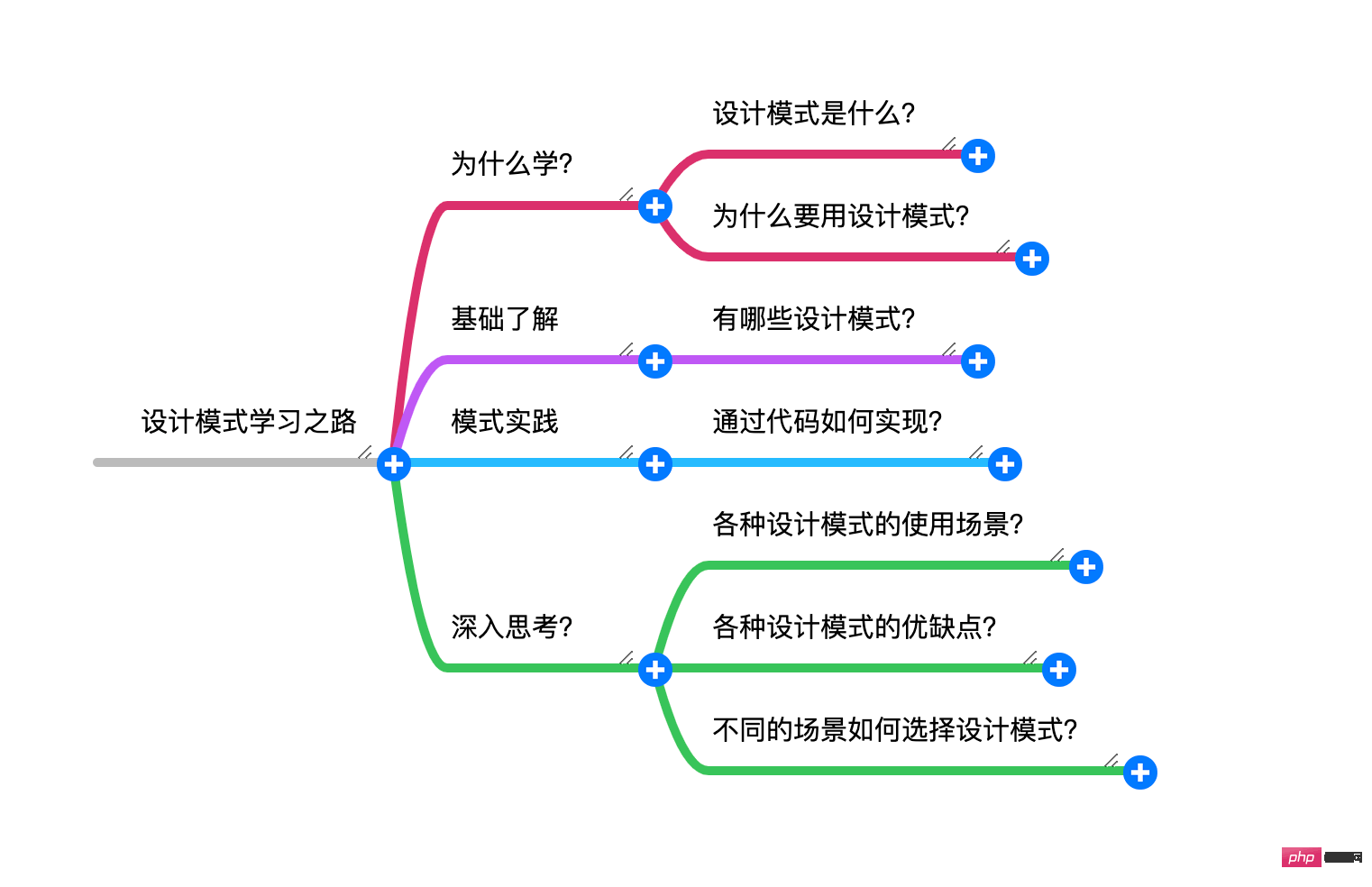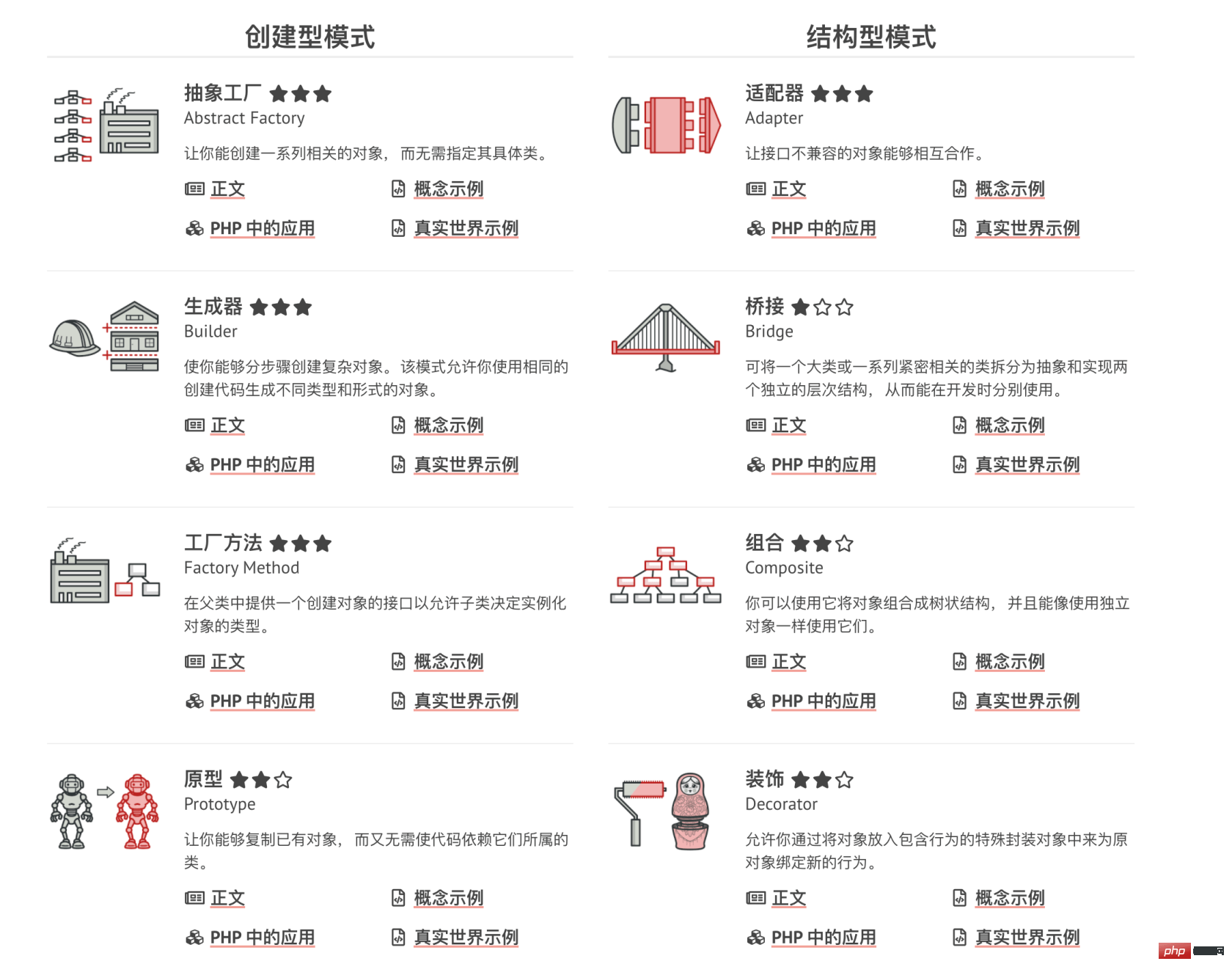Share PHP design pattern learning summary
This article will introduce and share a summary of learning PHP design patterns. It has certain reference value. Friends in need can refer to it. I hope it will be helpful to everyone.
Focus on PHP, MySQL, Linux and front-end development. If you’re interested, thank you for following us! ! ! The articles are organized on GitHub and mainly include technologies such as PHP, Redis, MySQL, JavaScript, HTML&CSS, Linux, Java, Golang, Linux and tool resources and other related theoretical knowledge, interview questions and practical content.
Article summary
This article will share with you a super practical design pattern learning website. Before learning design patterns, first we need to know why we learn design patterns? How to have a correct and efficient learning design model? The following figure lists a general learning idea for individuals in the process of learning design patterns: 
What is design pattern
Design pattern is software Typical solutions to common problems in design. They are like pre-made blueprints that can be adapted to your needs and can be used to solve recurring design problems in your code.
Design patterns are different from the way methods or libraries are used. It is difficult for you to directly apply a design pattern in your own program. A pattern is not a specific piece of code, but a general concept that solves a specific problem. You can use the pattern to implement a solution that meets your actual needs.
People often confuse patterns and algorithms because both are conceptually known to be typical solutions to specific problems. But while an algorithm always clearly defines a series of steps required to achieve a specific goal, a pattern is a higher-level description of a solution. The implementation code of the same pattern in two different programs may be different.
Algorithms are more like recipes: providing clear steps to achieve a goal. Patterns are more like blueprints: you can see the end result and the functionality of the pattern, but you need to determine the implementation steps yourself.
History of Design Pattern Development
Who invented the design pattern? This is a good question, but also a little inaccurate. Design patterns are not arcane, complex concepts - quite the opposite in fact. Patterns are typical solutions to common problems in object-oriented design. The same solutions were used over and over in various projects, so eventually someone gave them a name and described them in detail. This is basically the process of pattern discovery.
The concept of pattern was first proposed by Christopher Alexander in his book "Architectural Pattern Language". This book introduces the "language" of urban design, the basic unit of which is the pattern. Patterns might include descriptions of how high windows should be, how many stories a building should have, and how much vegetation a block should have.
Four authors, Erich Gamma, John Freesides, Ralph Johnson, and Richard Helm, embraced the concept of patterns. In 1994, they published the book "Design Patterns: The Foundation for Reusable Object-Oriented Software", which applied the concept of design patterns to the field of program development. The book provided 23 patterns to solve various problems in object-oriented programming and quickly became a bestseller. Because the title was so long, it was shortened to "The Gang of Four (GoF) Book" and was soon further shortened to "The GoF Book".
Since then, people have discovered dozens of object-oriented patterns. The "pattern approach" became popular in other areas of program development. Nowadays, many other patterns have been proposed outside the field of object-oriented design.
Design pattern classification
Different design patterns vary in complexity, level of detail, and scope of application in the entire system. I like to compare it to road construction: if you want to make intersections safer, you install some traffic lights, or build multi-level interchanges that include pedestrian underpasses.
The most basic, low-level patterns are often called idioms. This type of pattern can generally only be used in one programming language.
The most common, high-level pattern is the architectural pattern. Developers can use this type of pattern in any programming language. Unlike other patterns, they can be used to architect the entire application.
Furthermore, all patterns can be classified according to their intent or purpose. This book covers three main pattern categories:
The creational pattern provides a mechanism for creating objects, increasing the flexibility and reusability of existing code.
Structural patterns describe how to assemble objects and classes into larger structures while keeping the structures flexible and efficient.
Behavioral patterns are responsible for efficient communication and delegation of responsibilities between objects.
Through the picture below, it is roughly listed as follows: 
Pattern practice
Shared above Learn some basic knowledge about design patterns. We also have a certain understanding of the development history and classification of design patterns, and then practice through code. When learning design patterns, everyone will often encounter a problem.
The same design pattern can be implemented in programming language A, but I don’t know how to implement it in programming language B.
Beginners, because the programming language used in the books or articles they read does not match the programming language they currently master, it makes learning more difficult.
For the above problems, this website will help you solve them one by one. The website has sample codes for different programming languages, which can satisfy most learners.
Learning method
In the sample code, not only the definition of the design pattern is introduced, but also the logic diagram, UML diagram, actual code, and practical environment. At the same time, the biggest highlight is to summarize the design patterns through real life environment cases, which helps to understand the design patterns. The following figure is the general idea of learning the design pattern sample code: 
Website address
The above roughly lists some basic knowledge of the design pattern. There are also ways and means to learn website design patterns. The specific URL of the website is: refactoringguru.cn/design-patterns
Recommended: "PHP Video Tutorial"
The above is the detailed content of Share PHP design pattern learning summary. For more information, please follow other related articles on the PHP Chinese website!

Hot AI Tools

Undresser.AI Undress
AI-powered app for creating realistic nude photos

AI Clothes Remover
Online AI tool for removing clothes from photos.

Undress AI Tool
Undress images for free

Clothoff.io
AI clothes remover

AI Hentai Generator
Generate AI Hentai for free.

Hot Article

Hot Tools

Notepad++7.3.1
Easy-to-use and free code editor

SublimeText3 Chinese version
Chinese version, very easy to use

Zend Studio 13.0.1
Powerful PHP integrated development environment

Dreamweaver CS6
Visual web development tools

SublimeText3 Mac version
God-level code editing software (SublimeText3)

Hot Topics
 1377
1377
 52
52
 PHP 8.4 Installation and Upgrade guide for Ubuntu and Debian
Dec 24, 2024 pm 04:42 PM
PHP 8.4 Installation and Upgrade guide for Ubuntu and Debian
Dec 24, 2024 pm 04:42 PM
PHP 8.4 brings several new features, security improvements, and performance improvements with healthy amounts of feature deprecations and removals. This guide explains how to install PHP 8.4 or upgrade to PHP 8.4 on Ubuntu, Debian, or their derivati
 Discuss CakePHP
Sep 10, 2024 pm 05:28 PM
Discuss CakePHP
Sep 10, 2024 pm 05:28 PM
CakePHP is an open-source framework for PHP. It is intended to make developing, deploying and maintaining applications much easier. CakePHP is based on a MVC-like architecture that is both powerful and easy to grasp. Models, Views, and Controllers gu
 CakePHP File upload
Sep 10, 2024 pm 05:27 PM
CakePHP File upload
Sep 10, 2024 pm 05:27 PM
To work on file upload we are going to use the form helper. Here, is an example for file upload.
 How To Set Up Visual Studio Code (VS Code) for PHP Development
Dec 20, 2024 am 11:31 AM
How To Set Up Visual Studio Code (VS Code) for PHP Development
Dec 20, 2024 am 11:31 AM
Visual Studio Code, also known as VS Code, is a free source code editor — or integrated development environment (IDE) — available for all major operating systems. With a large collection of extensions for many programming languages, VS Code can be c
 How do you parse and process HTML/XML in PHP?
Feb 07, 2025 am 11:57 AM
How do you parse and process HTML/XML in PHP?
Feb 07, 2025 am 11:57 AM
This tutorial demonstrates how to efficiently process XML documents using PHP. XML (eXtensible Markup Language) is a versatile text-based markup language designed for both human readability and machine parsing. It's commonly used for data storage an
 CakePHP Quick Guide
Sep 10, 2024 pm 05:27 PM
CakePHP Quick Guide
Sep 10, 2024 pm 05:27 PM
CakePHP is an open source MVC framework. It makes developing, deploying and maintaining applications much easier. CakePHP has a number of libraries to reduce the overload of most common tasks.
 PHP Program to Count Vowels in a String
Feb 07, 2025 pm 12:12 PM
PHP Program to Count Vowels in a String
Feb 07, 2025 pm 12:12 PM
A string is a sequence of characters, including letters, numbers, and symbols. This tutorial will learn how to calculate the number of vowels in a given string in PHP using different methods. The vowels in English are a, e, i, o, u, and they can be uppercase or lowercase. What is a vowel? Vowels are alphabetic characters that represent a specific pronunciation. There are five vowels in English, including uppercase and lowercase: a, e, i, o, u Example 1 Input: String = "Tutorialspoint" Output: 6 explain The vowels in the string "Tutorialspoint" are u, o, i, a, o, i. There are 6 yuan in total
 Explain JSON Web Tokens (JWT) and their use case in PHP APIs.
Apr 05, 2025 am 12:04 AM
Explain JSON Web Tokens (JWT) and their use case in PHP APIs.
Apr 05, 2025 am 12:04 AM
JWT is an open standard based on JSON, used to securely transmit information between parties, mainly for identity authentication and information exchange. 1. JWT consists of three parts: Header, Payload and Signature. 2. The working principle of JWT includes three steps: generating JWT, verifying JWT and parsing Payload. 3. When using JWT for authentication in PHP, JWT can be generated and verified, and user role and permission information can be included in advanced usage. 4. Common errors include signature verification failure, token expiration, and payload oversized. Debugging skills include using debugging tools and logging. 5. Performance optimization and best practices include using appropriate signature algorithms, setting validity periods reasonably,




